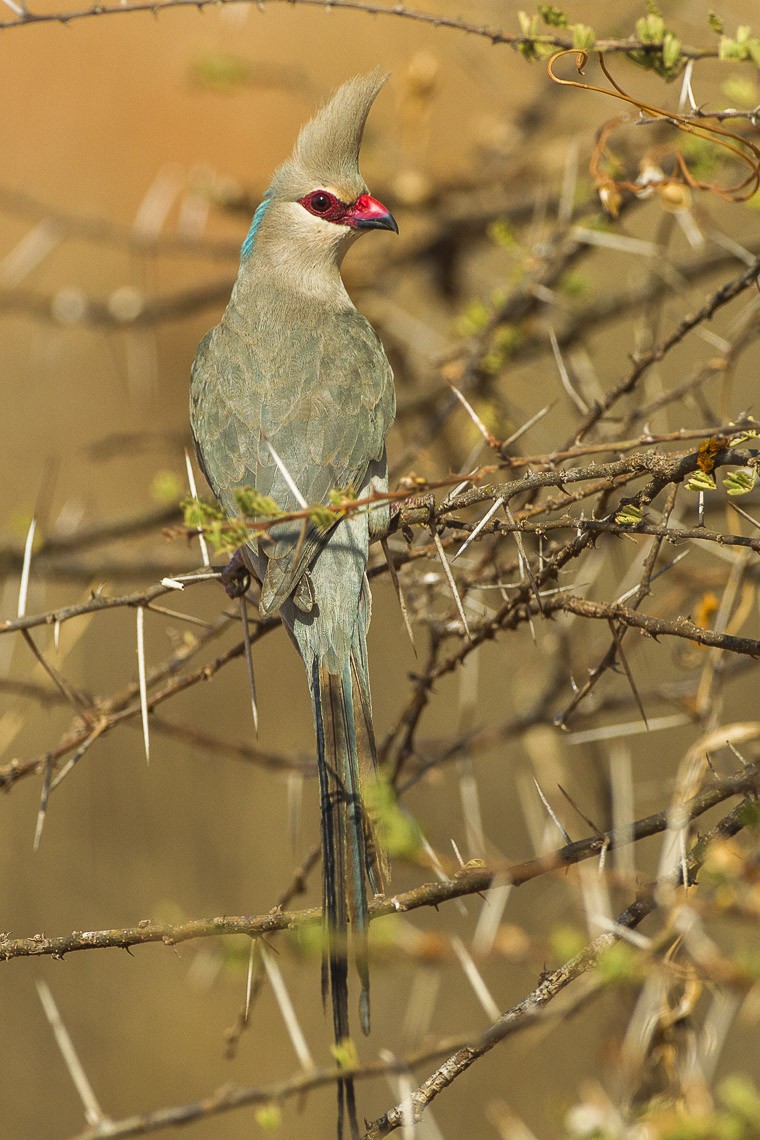Blue-naped Mousebird
A species of Red-billed Mousebirds Scientific name : Urocolius macrourus Genus : Red-billed Mousebirds
Blue-naped Mousebird, A species of Red-billed Mousebirds
Botanical name: Urocolius macrourus
Genus: Red-billed Mousebirds
Content
Description General Info
 Photo By Francesco Veronesi , used under CC-BY-SA-2.0 /Cropped and compressed from original
Photo By Francesco Veronesi , used under CC-BY-SA-2.0 /Cropped and compressed from original Description
The blue-naped mousebird is a fairly small to medium-sized bird, measuring 13-14 inches in length. Adults have an ash brown, grayish body, crested head with a turquoise nape, and a black-and-red bill, whereas juveniles lack the blue on nape, and have pink facial skin and greenish bills. Characteristic of mousebirds, the blue-naped mousebird has widely spaced and large feet for its body size, which are pamprodactylous; they are able to rotate all four toes to face forward at will. Their toes are strong and dextrous, allowing the birds to climb and scurry along branches, to hang by a toenail, or to use one foot to hold food. 
Size
36 cm
Nest Placement
Tree
Feeding Habits
Blue-naped Mousebird feasts mainly on fruits like berries, dates, and cultivated varieties, particularly Salvadora persica. They supplement with leaves, flowers, and buds. Flocking in groups, they forage methodically, following daily routes to known fruiting trees, displaying a unique, systematic foraging behavior.
Habitat
Blue-naped Mousebird typically inhabit open woodland and bushland in semi-arid regions within broader eastern Africa. Preferring thornbush and savanna landscapes, they are also found in Acacia woodlands, frequently near watercourses, wells, palm groves, farms, and the outskirts of urban areas including villages and towns. Blue-naped Mousebird thrive from sea level up to elevations of 2000 meters, usually below 1600 meters, adapting to a variety of dry habitats, even when overlapping with similar species.
Dite type
Granivorous
General Info
Feeding Habits
Bird food type
Distribution Area
In the wild, these birds live in the semi-desert and dry regions of eastern Africa They are found in a band between 10°N and 20°N from the western coast to Sudan, Djibouti, Eritrea, Ethiopia and Somalia in the East and south 10°N through East Africa and on to the Eastern Zaire borders. This species has an extremely large range, and hence does not approach the thresholds for Vulnerable under the range size criterion (Extent of Occurrence <20,000 km2 combined with a declining or fluctuating range size, habitat extent/quality, or population size and a small number of locations or severe fragmentation). Despite the fact that the population trend appears to be decreasing, the decline is not believed to be sufficiently rapid to approach the thresholds for Vulnerable under the population trend criterion (>30% decline over ten years or three generations). The population size has not been quantified, but it is not believed to approach the thresholds for Vulnerable under the population size criterion (<10,000 mature individuals with a continuing decline estimated to be >10% in ten years or three generations, or with a specified population structure). For these reasons the species is evaluated as least concern. 
Species Status
Not globally threatened.
Scientific Classification
Phylum
Chordates Class
Birds Order
Mousebirds Family
Mousebirds Genus
Red-billed Mousebirds Species
Blue-naped Mousebird